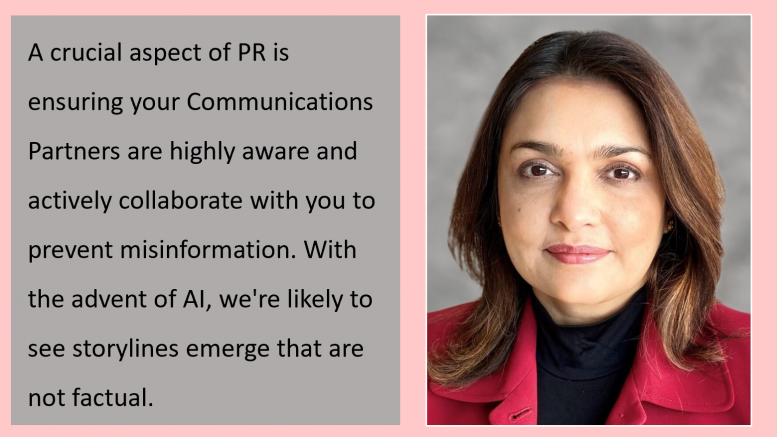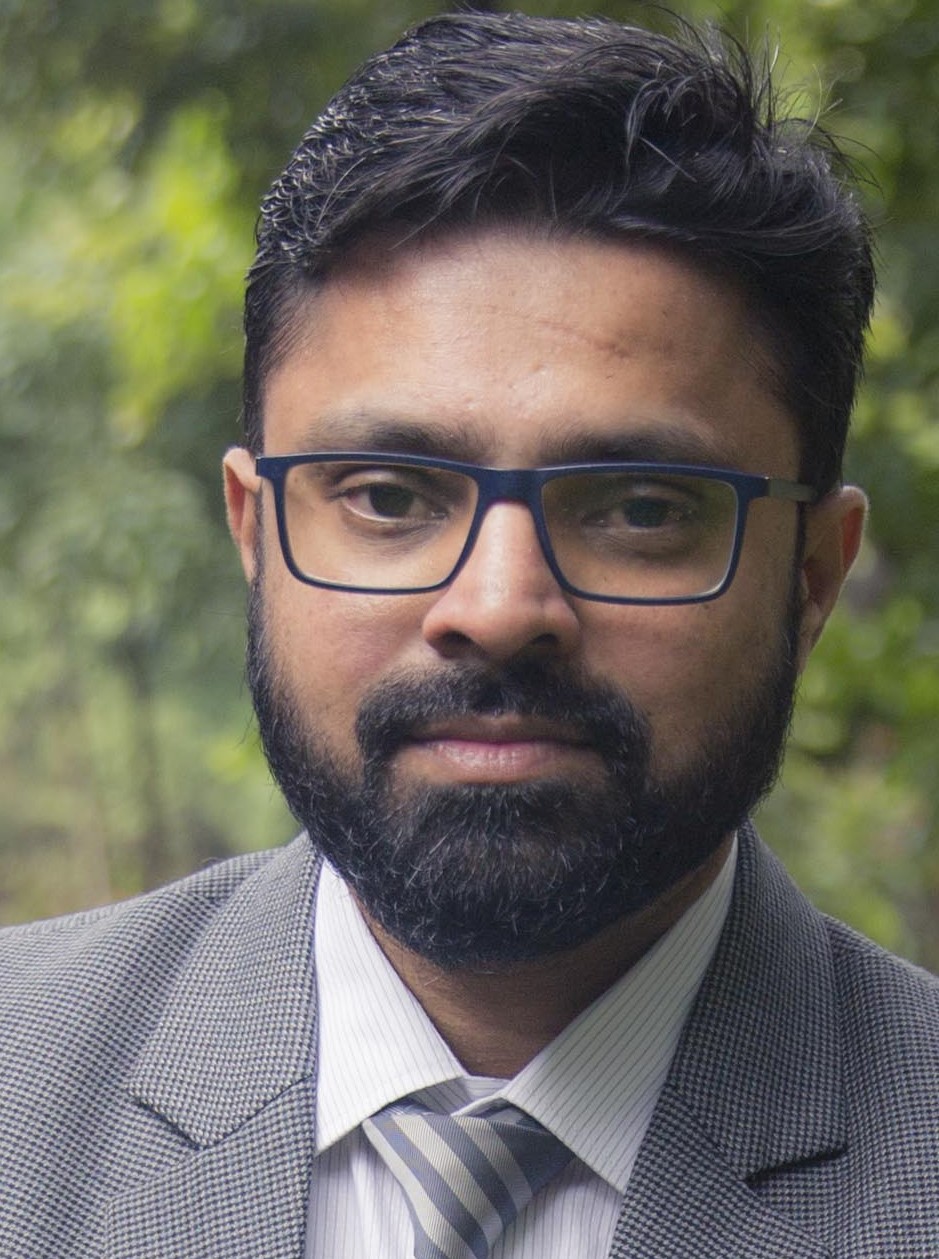In this exclusive interview with Reputation Today, Roopa Unnikrishnan, SVP, Strategy and Corporate Development, IDEX, we explore the dynamic intersections of technology, leadership, and public relations in the constantly evolving business landscape. Roopa shares invaluable insights on adapting to changes in the health and technology sectors, underscoring the necessity of strategic agility and scenario planning. She offers her unique perspective on the role of empathy in business relationships and its crucial importance in negotiations and achieving long-term success. Drawing from her experiences in sports, Roopa highlights the significance of maintaining focus amidst distractions and the value of learning from every outcome, be it a triumph or a setback. Additionally, the interview illuminates Roopa’s views on the evolving role of PR in countering misinformation in the AI era, emphasising the need for communication professionals to remain vigilant and well-informed. This conversation is a treasure trove of strategies and wisdom for anyone seeking to navigate the complex world of business with foresight and adaptability.
Hemant Gaule: The health and technology sectors are constantly evolving, what are some emerging trends that can be most promising and fulfilling for strategic planning in this sector?
Roopa Unnikrishnan: The reality is that there’s change happening in virtually every industry. You could be in the legal environment, where transformation is occurring. It’s not just about AI; it’s also about how people expect to receive services.
What was once a specialised area is now becoming democratised. This transformation is widespread. An important element to consider in strategic planning is tracking these megatrends. It involves shifting from static strategic planning to a scenario planning mindset. This means considering eight to ten rational scenarios that could affect your business. You might have an infinite number of scenarios to consider, from best case to worst case. Position your business in the middle of these scenarios and think about which ones could be catastrophic or highly beneficial. Identifying a few key threads that allow you to mitigate risk and foster growth is essential.
In the business that I’m in, for example, it’s clear that we want to focus on sustainability and very specific precision efforts. As long as you can hone in on four or five important elements that mitigate risk and aid growth, you’re generally in a good position. However, you need to consider as many realistic scenarios as possible.
Take life sciences, for instance. Demographics are changing; people are getting older. We are seeing more pandemics, increased pressures like access to food and water, which change demographic behaviors. With more people in areas with limited resources, there’s a higher likelihood of infectious diseases. However, with access to medical technology, people are living longer. Depending on your business, you need to consider all these factors, mix them up, and see what scenarios emerge.
I’m not predicting the future for you because it all depends on your business and how you interpret these trends. There’s almost always a way forward for most businesses to find a pathway to success, I believe.
HG: It seems like it’s crucial and challenging to be agile and be able to line it all up all those scenarios up with what your business goals are, particularly in this space, right?
RU: It is. I think one of the benefits of being in the company I’m with is our broad portfolio of businesses. We have businesses in life sciences, associated with healthcare. But we also focus on agriculture, water, industrial fluid control and management, fire safety, and paints.
We have a broad portfolio, which allows us to both mitigate risk and grow. A significant part of my job is portfolio management, managing the businesses we’re involved in, mostly on the growth side, adding to it through various measures. We also take a very tough look at some businesses that may thrive better in other companies. Our philosophy is that you have to be very disciplined. There are other types of companies where the metrics we aspire to may not be necessary.
HG: In your book ‘The Career Catapult-Shake-Up the Status Quo and Boost Your Professional Trajectory’, you mentioned the uncertainty of our future and how we can take the reins of the same to mold it according to our advantage, what according to you are the steps, or how do we modify ourselves for that?
RU: Yes, in my book, which I’m refining again for the world of AI, I laid out a series of steps. It’s somewhat chronological, but these steps can be done simultaneously. It starts with introspection. Dig deep to understand your core capabilities, passions, and blind spots. For example, if you don’t want the pressures of being a CEO, like dealing with investors and quarterly calls, reconsider if that’s your goal. Maybe your strengths lie in data analysis.
It’s about listening to yourself, not just the voices from the outside world. You might convince yourself you’re the best person to talk to investors, but if you lack empathy for their needs, that’s something to consider. It’s not just desk work; it’s about incorporating this introspection into your daily routine. For instance, think about your passions and learnings while on your morning jog or doing laundry. Open the newspaper and notice which section you go to first – this indicates your interests.
Secondly, pay close attention to trends. Don’t just observe trends superficially, delve deep into them. Understand the nuances of trends, like logistics in shipping, by researching and analysing who is succeeding and why.
Thirdly, prototype your possibilities. Think of it like writing a novel. Lay out your potential paths and engage with your network, whether through LinkedIn, conferences, or auditing classes. If you’re working, meet people from different functions in your company. Even if you’re early in your career, you bring value by being new or young. Use that as a ticket to learn from others. Start prototyping your career by visualising yourself in different roles and environments. Volunteer, for example, in fundraising for a non-profit or helping startups design pitchbooks. This can frame your experience and prepare you to evolve within an organisation.
HG: As you have mentioned about human sensitivity, can empathy be related to emotional sensitivity, and what role does it play in building meaningful connections with others?
RU: Yes, that’s a great question. There are two types of people: those who are naturally empathetic and those for whom empathy is a learned skill. Both need to find their path to success. If you find yourself getting drawn into drama or art, it’s important to create boundaries in how you see the world through someone else’s eyes, which is often what empathy looks like.
For those who don’t naturally approach situations empathetically, it’s about creating a discipline. Going into any interaction, think, ‘There is something I can learn from this person.’ Build a slightly selfish motivation towards gaining empathy by considering what makes the person tick and how their perspective might be valuable.
This approach is crucial in various situations, such as negotiations, acquisitions, or commercial conversations. While there’s a belief that winning a deal means getting it your way without middle ground, I think it’s nuanced. Most relationships should be viewed as long-term rather than purely transactional. This mindset often results in better outcomes.
Even in transactional businesses like banking, bankers who remember the value of relationships – understanding that sometimes you’re selling, sometimes buying – tend to succeed. There’s a finite group of valuable relationships out there, so investing in them is worthwhile. A smart banker thinks about empathy and building deeper relationships.
HG: What lessons do you take and advocate from your experience in sports to leadership and strategic planning in the world of business?
RU: The biggest lesson sports, particularly shooting, taught me is the ability to be open to multiple inputs while staying focused. In shooting, you deal with wind, light changes, noise from competitors, etc. You learn to tune in and out as necessary. For instance, a changing wind affects your ability to shoot perfectly. It’s about finding a specific flag to watch, the correct flag, to ensure you’re on track.
Another key lesson is recognising that the past is no indicator of the future. This is a common understanding in financial analysis: past performance is no indication of future success. It’s the same in shooting. If you shoot a perfect 10, it has no bearing on whether your next shot will be a 10. You have to start from scratch each time, putting a system in place for each new shot.
Similarly, if you score a 7, it’s not productive to get frustrated. Accept it, maybe feel frustrated for a moment, but then you must move on. Compartmentalise the experience and approach each new shot as if it should be a 10.
These lessons are very valuable in business leadership and strategic planning. They teach the importance of staying open to new information, not dwelling on past successes or failures, and always starting fresh with each new challenge.
HG: What strategies can businesses use to stay agile and adapt their PR efforts in response to changing circumstances and unforeseen events?
RU: A crucial aspect of PR is ensuring your Communications Partners are highly aware and actively collaborate with you to prevent misinformation. With the advent of AI, we’re likely to see storylines emerge that are not factual. The key is to first recognise these inaccuracies and then mitigate them. This will become an important tool in the communicator’s handbook. I strongly urge every PR and communications professional to stay on top of this game. It’s essential to know how to handle these situations effectively and swiftly.
The responses above are from Roopa Unnikrishnan as shared with Reputation Today



Be the first to comment on "In Conversation with Roopa Unnikrishnan"